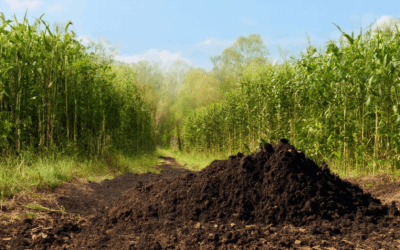Eco-friendly agricultural solutions are revolutionizing the way modern farming operates, offering practical alternatives that not only protect the environment but also enhance productivity and long-term sustainability. As global concerns about climate change, soil degradation, and resource depletion grow, farmers and agricultural professionals are increasingly seeking innovative approaches to reduce their ecological footprint while maintaining high yields and crop quality. From reducing reliance on synthetic chemicals to adopting organic farming methods and integrating cutting-edge technologies, eco-friendly agricultural practices are proving to be essential for ensuring the future of agriculture. In this comprehensive guide, we explore the latest trends, tools, and techniques that are transforming farming into a more sustainable and environmentally responsible endeavor.

What Are Eco-Friendly Agricultural Products?
Eco-friendly agricultural products are goods and services that support sustainable farming practices, focusing on environmental protection, resource efficiency, and reduced chemical use. These products often adhere to strict certification standards and are produced using methods that minimize harm to the environment while maximizing productivity.
Key Characteristics of Eco-Friendly Agricultural Products:
- Organic Farming :
Products certified as organic are grown without synthetic pesticides, herbicides, or artificial fertilizers. This approach preserves biodiversity, promotes soil health, and reduces contamination of water and air. - Crop Rotation and Agroforestry :
Practices like crop rotation and agroforestry enhance soil fertility and reduce reliance on chemical inputs. Crop rotation improves soil structure and prevents pests, while agroforestry integrates trees into farming systems to provide shade, reduce erosion, and sequester carbon. - Biochar Usage :
Biochar, produced through pyrolysis of organic materials, acts as a soil amendment. It improves soil fertility, reduces greenhouse gas emissions, and enhances water retention, making it a valuable component of eco-friendly farming. - Cover Cropping :
Cover crops, such as clover or rye, are planted to protect soil from erosion and enrich it with organic matter. This practice supports sustainable farming by improving soil health and reducing the need for synthetic inputs. - Integrated Pest Management (IPM) :
IPM combines biological, cultural, and chemical methods to control pests. By minimizing the use of harmful pesticides, IPM promotes biodiversity and reduces environmental impact. - Local and Seasonal Produce :
Consuming food that is locally grown and in season minimizes transportation emissions and supports regional economies. Local farmers often practice eco-friendly farming due to smaller operations and closer connection to their land. - Composting :
Composting transforms kitchen scraps and yard waste into nutrient-rich soil amendments, promoting sustainable farming and reducing landfill waste.
Certifications for Eco-Friendly Products:
Products labeled with certifications like USDA Organic, Fair Trade, and Rainforest Alliance meet rigorous environmental and social standards. These certifications help consumers identify products that align with eco-friendly values.
Benefits of Eco-Friendly Agricultural Products:
- Environmental Protection : Reduced chemical use and sustainable farming methods decrease pollution and conserve water and air quality.
- Soil Health : Practices like crop rotation and composting improve soil fertility and resilience.
- Climate Resilience : Eco-friendly farming techniques build stronger, more adaptable crops capable of thriving in changing conditions.
- Sustainable Economies : Supporting local farmers and businesses fosters community vitality and strengthens regional economies.
By choosing eco-friendly agricultural products, consumers contribute to a healthier planet and a more sustainable future.
Most Environmentally Friendly Agricultural Practices
The most environmentally friendly agricultural practices involve a combination of sustainable methods that minimize harm to ecosystems while maximizing productivity. Here are some key approaches:
- Organic Farming : This practice avoids synthetic chemicals, promoting natural processes like composting and crop rotation to maintain soil health.
- Agroforestry : Integrating trees with crops enhances soil fertility, reduces erosion, and captures carbon dioxide.
- Crop Diversification : Rotating crops improves soil health and reduces reliance on pesticides, supporting biodiversity.
- Reduced Tillage : Minimizing soil disturbance conserves water, prevents erosion, and lowers energy use.
- Integrated Pest Management : Using natural predators or traps instead of chemicals helps protect crops and local wildlife.
- Permaculture : Designing systems that mimic natural ecosystems for food production and waste management.
- Regenerative Agriculture : Focuses on healing degraded lands through organic matter addition and diverse planting patterns.
Each of these practices contributes to environmental sustainability by reducing chemical use, preserving biodiversity, and promoting carbon sequestration. A holistic approach combining these methods yields the most eco-friendly outcomes.

How Can We Make Agriculture More Environmentally Friendly?
Agriculture plays a significant role in shaping our environment, and adopting eco-friendly practices can help protect ecosystems while ensuring food security. Here are some effective ways to make agriculture more environmentally friendly:
- Adopt Organic Farming Practices : Reduce reliance on synthetic pesticides and fertilizers by switching to organic methods. This not only improves soil health but also reduces contamination of water sources and air quality.
- Implement Crop Rotation : Rotating crops helps control pests and diseases, reduces soil degradation, and minimizes the need for chemical inputs. This practice enhances biodiversity and overall farm productivity.
- Use Cover Crops : Planting cover crops like clover or rye can protect soil from erosion, improve moisture retention, and provide habitats for beneficial insects and birds.
- Practice Integrated Pest Management (IPM) : Combine biological, cultural, and chemical methods to manage pests effectively. This approach reduces the need for harmful chemicals and supports natural predators of pests.
- Support Local Farmers and Markets : Buying locally-grown products reduces transportation emissions and supports sustainable farming practices. It also helps preserve biodiversity and traditional farming methods.
- Use Renewable Energy Sources : Transitioning to solar or wind energy systems for farming operations can significantly reduce carbon footprints and lower energy costs.
- Conserve Water Resources : Install drip irrigation systems and rainwater harvesting technologies to minimize water usage and promote efficient resource management.
- Promote Agroforestry : Integrate trees and shrubs into farming systems to enhance soil fertility, provide shade for crops, and improve air quality while sequestering carbon dioxide.
By embracing these practices, we can create a more sustainable and resilient agricultural system that benefits both the environment and future generations. Let’s work together to make agriculture a model of ecological stewardship.

Most Environmentally Friendly Agricultural Technique
The most environmentally friendly agricultural technique is **agroforestry**, which integrates trees and crops in a farm system. This practice enhances biodiversity, improves soil health, and reduces greenhouse gas emissions by acting as a carbon sink. By planting trees alongside crops, agroforestry provides shade, retains moisture, and fosters a sustainable ecosystem.
Another highly ranked technique is **no-till farming**, which avoids plowing the soil, thereby preserving its structure and organic matter. This method reduces erosion, minimizes water runoff, and decreases greenhouse gas emissions associated with machinery use. It promotes soil health and carbon sequestration, making it a strong contender for eco-friendliness.
Organic farming and permaculture also excel in environmental friendliness by avoiding synthetic chemicals and promoting natural processes. These methods enhance biodiversity, conserve resources, and reduce pollution, further supporting sustainable agricultural practices.
Ultimately, the choice depends on specific environmental goals and regional conditions. However, agroforestry and no-till farming stand out as leading examples of eco-friendly techniques due to their broad benefits and scalability.
- Agroforestry: Enhances biodiversity, improves soil fertility, and combats climate change by sequestering carbon.
- No-Till Farming: Reduces soil erosion, preserves organic matter, and lowers carbon emissions through decreased machinery use.
- Organic Farming: Uses natural methods to maintain soil health and reduce chemical runoff.
- Permaculture: Creates self-sustaining ecosystems through companion planting and local species selection.
- Integrated Pest Management (IPM): Minimizes pesticide use and promotes biological controls to protect ecosystems.
- Cover Cropping: Protects soil from erosion and enriches it with nutrients while providing habitats for pollinators.
- Agroecology: Combines agriculture with ecological principles to design renewable resource systems and support biodiversity.
What is the Most Sustainable Form of Agriculture?
The most sustainable form of agriculture depends on various factors such as resource efficiency, biodiversity, and environmental impact. Here are some of the leading methods:
- Organic Farming :
- Uses natural methods without synthetic chemicals, promoting biodiversity and reducing pollution.
- Enhances soil health and reduces greenhouse gas emissions.
- Reduces reliance on external inputs, making it adaptable to different environments.
- Agroforestry :
- Integrates trees with crops and livestock, improving soil health and erosion control.
- Provides shade for plants and supports pollinators, increasing biodiversity.
- Contributes to carbon sequestration, helping combat climate change.
- Permaculture :
- Mimics natural ecosystems through techniques like mulching and companion planting.
- Builds system resilience and reduces the need for external inputs.
- Promotes self-sufficiency and long-term food security.
- Hydroponics :
- Conserves water and avoids soil damage, making it ideal for arid regions.
- Reduces chemical use, minimizing environmental contamination.
- Requires controlled environments, which can be energy-intensive.
- Vertical Farming :
- Uses less land and minimizes tillage, preserving soil integrity.
- Ideal for urban settings, but may have higher energy costs depending on the setup.
Each method has unique advantages, and the most sustainable approach often combines these practices. For instance, integrating organic farming with agroforestry can enhance biodiversity and reduce environmental impact. The choice of method should consider local conditions, resources, and the specific goals of the farmer or community.
By adopting a holistic approach that includes multiple sustainable practices, agriculture can achieve higher levels of environmental, economic, and social benefit, contributing to a healthier planet for future generations.

What is Permaculture Farming?
Permaculture farming is a sustainable agricultural system that mimics the natural patterns found in ecosystems. It focuses on creating a self-reliant, long-lasting food production system that works with nature rather than against it. Established by Bill Mollison and others, permaculture emphasizes biodiversity, soil health, and resource efficiency.
Key Concepts of Permaculture Farming:
- Design Systems : Permaculture involves designing ecosystems that integrate plants, animals, and microorganisms to work together sustainably. This includes techniques like mulching, companion planting, and crop rotation.
- Sustainable Practices :
- Mulching : Retains moisture, suppresses weeds, and regulates soil temperature.
- Companion Planting : Plants are chosen to support each other, such as nitrogen-fixers like legumes and pest-repelling varieties.
- Agroforestry : Integrates trees and other crops to create a forest-like system that enhances biodiversity and soil health.
- Benefits :
- Improved Soil Health : Reduced tillage leads to higher organic matter retention.
- Water Efficiency : Natural systems often require less irrigation due to better moisture retention.
- Biodiversity : Increases species diversity compared to conventional farming methods.
- Types of Permaculture Systems :
- Forest Permaculture : Mimics a woodland habitat with layers of plants.
- Agroforestry : Combines trees with crops and livestock.
- Market Gardening : Intensive, small-scale farming focused on edible plants.
- Practices :
- Composting : Recycles organic waste into nutrient-rich fertilizers.
- Renewable Energy : Uses solar panels or wind turbines for power.
- Water Management : Techniques like rainwater harvesting and swales to handle water resources.
- Challenges :
- Initial setup costs and learning curves.
- Managing pests and diseases in a natural setting.
Conclusion:
Permaculture farming offers a holistic approach to agriculture, promoting sustainability and resilience. By aligning with natural processes and integrating diverse practices, farmers can achieve higher productivity and environmental balance.




0 Comments